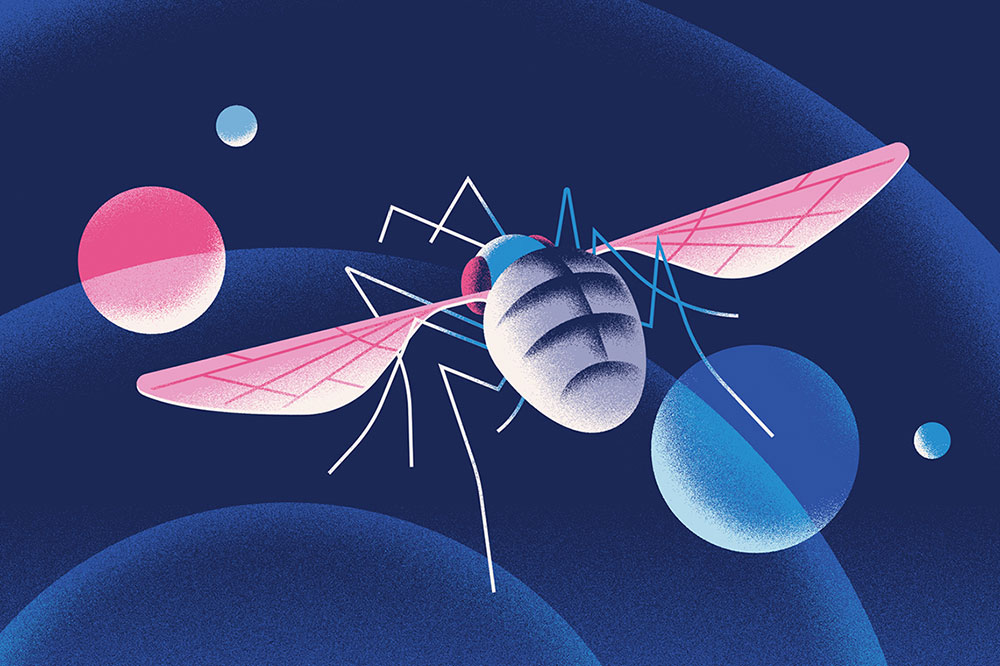Fruit flies find their way by setting navigational goals

Inside the tiny fly brain are sophisticated navigational mechanisms that that get the insect where it needs to go.
When a fruit fly decides it wants to walk in a particular direction, it sticks to its plan with impressive resolve. Now, Rockefeller scientists have begun to understand how insect brains make and meet navigational goals.
In monitoring itinerant flies, the researchers showed that the animals compare their current heading direction to a goal direction, calculate the difference, and use this information to inform their next step. These findings, described in Nature Neuroscience, shed light on how brains use internal goals to direct moment-to-moment actions at a cellular level.
One direction
Animals ranging from insects to mammals have specific neurons that keep track of which way they’re facing. Referred to as head-direction or heading cells, these neurons play a vital role in an animal’s survival (it’s difficult to search for resources like food or shelter if you can’t keep track of which way you’re currently heading).
Still, scientists remained unsure of how heading cells guide moment-to-moment behavior—how, for example, the neurons might prompt an animal to turn left or right, speed up or slow down. To investigate these questions, Jonathan Green, Vikram Vijayan and Peter Mussells Pires—researchers in the lab of Gaby Maimon—analyzed ambling fruit flies.
“These flies will walk in the same direction for meters at a time,” says Maimon. “But we wanted to prove that they’re not just walking straight by chance—we believed that they have an internal goal direction, along which they intend to walk.”
In a series of experiments, the researchers tethered individual flies to a plate with a tiny fly-sized hole, which kept them in place. The flies then walked on an air-cushioned ball, which rotates as the animal scampers along its surface. Surrounding the ball was a cylindrical LED array, with one vertical line illuminated. This bright bar served as a visual landmark that, to the flies, might register as the sun, the moon, or some other distant reference point by which keep track of their heading.
As the researchers had anticipated, the flies excelled at walking in a straight line with reference to the bright stimulus. For example, if an animal began its journey with the illuminated bar 45 degrees to its right, then it often maintained this orientation for tens of minutes and sometimes over an hour (a long pilgrimage for flies). More impressively, when the researchers manipulated the LED display such that bar jumped to the right or left, the animals turned their bodies until the bar was back at their preferred angle.
This experiment confirms that flies don’t walk straight by chance, but rather have an internally-generated goal orientation that informs their every step. Supporting this model, the researchers found that the further the LED bar shifted, the harder the animals turned their bodies.
Moreover, following a bar jump, the animals slowed down—suggesting that they move at full speed only when they know they’re walking along their goal direction.
Navigating the brain
Next, the researchers monitored and manipulated the brain activity of flies as they pursued navigational goals. Specifically, they tinkered with the flies’ heading cells, also called E-PGs, which are thought to act like a biological compass: As a fly turns, different E-PGs become active, creating an internal representation of the animal’s orientation.
By stimulating E-PGs, Maimon’s team was able to rotate the fly compass, leading the animals to believe that they were they were straying from their intended trajectory. Following this intervention, the researchers found, flies would slow their pace and turn at an angle commensurate with the degree to which their compass had been rotated.
This outcome suggests that flies aim to keep their neural compass needle at some internally-generated goal angle—and that they modify their behavior to ensure that the needle stays in that sweet spot. In other words, flies seem to use their internal compass-like neurons much like a hiker uses a traditional compass on a long hike.
The researchers conclude that while E-PGs track a fly’s current heading, a different group of neurons or a set of neuronal connections, not yet discovered, must store the animal’s goal direction. The fly brain then calculates the difference between its current direction and its goal to determine which way to turn, and how hard.
“We’ve known that flies have a compass-like system in their brain since 2015, but this work is the first to describe how the animals use this system to guide navigational behavior,” says Maimon. “Because mammalian brains have heading cells with similar properties, our work may ultimately help us better understand how humans navigate—a process that’s impaired in psychiatric disorders, like Alzheimer’s disease.”



